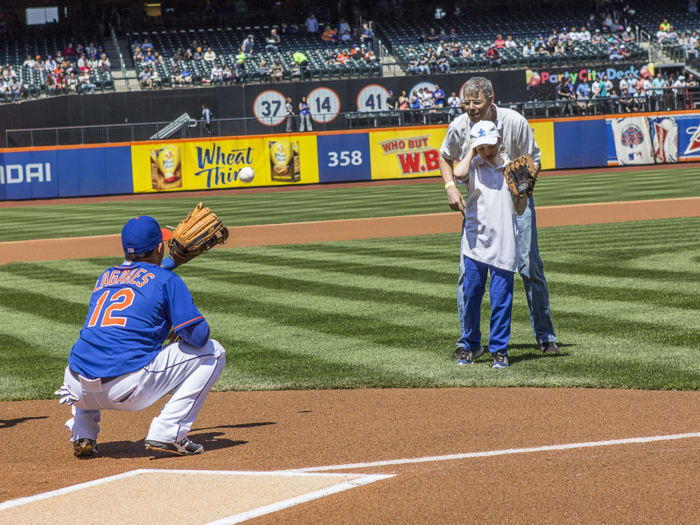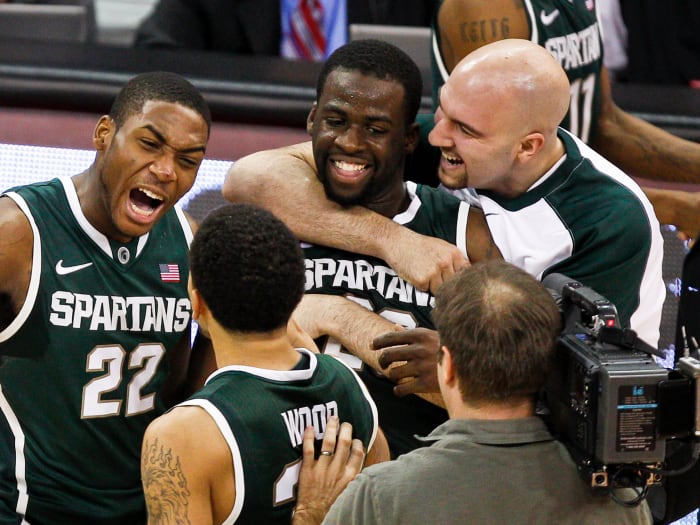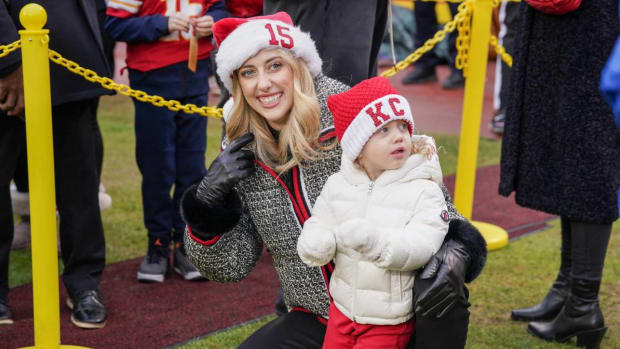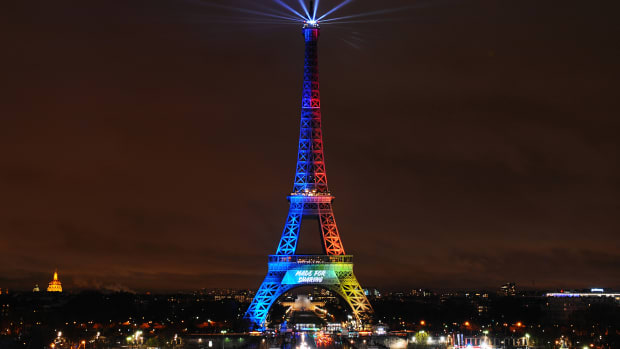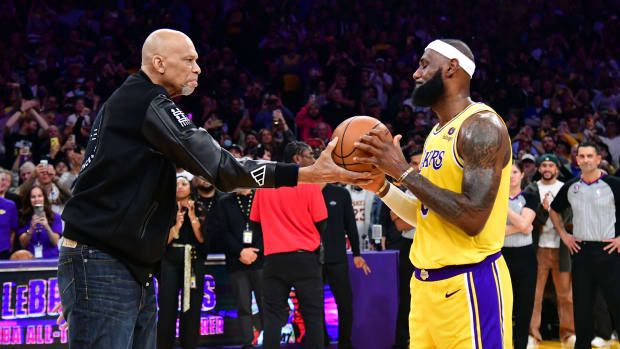Defying expectations, people with autism are participating and excelling in sports
SI's Jon Wertheim explores the growing intersection between sports and autism on Showtime’s 60 Minutes Sports, airing Tuesday, Nov. 1 at 8 p.m. ET on Showtime.
Before Draymond Green became the Warriors’ vocal center of gravity—their most voluble player, as it were—he served a similar role at Michigan State. In the summer of 2011 the Spartans went through a brutal off-season strength-and-conditioning regimen. As the players gasped for breath after a particularly taxing drill, Green smiled and said, “Y’all know you have to do it twice, right?”
That line cracked up his teammates—with one exception. Oblivious to Green’s sarcasm, 6’ 9” backup center Anthony Ianni grimaced, groaned and prepared for another rep, prompting even louder laughs. In what he calls a “burst-out moment,” Ianni scolded Green, who shot back that Ianni needed to learn how to take a joke. Before they could come to blows, the strength coach intervened, pulling Green aside. “Draymond, there are times Anthony doesn’t understand your humor,” the coach said. “See, Anthony has autism.”
That same summer Anthony Pantaleone signed up to play T-ball. This might have been an easy decision for thousands of other families in the northern New Jersey suburbs, but for Anthony and his mother, Amy McClelland, it followed much deliberation. Anthony, then an irrepressible five-year-old, had been diagnosed with autism in infancy. He was nonverbal until he was three and prone to “meltdowns,” as McClelland puts it, sometimes without apparent provocation. Still, Anthony could kick and run and jump. He warmed to sports-related activities, such as playing NBA 2K on his PlayStation. Not surprisingly, he was interested in joining a team.
McClelland knew that letting him do so defied conventional wisdom at the time. Individuals with autism spectrum disorder (ASD), a general term for a group of complex conditions of brain development, often lack physical coordination and fine-motor skills. They can also be unaware of their bodies, tending to stand too close to people or bumping into objects. What’s more, the autistic population can suffer from overstimulation and prefers clear rules and quiet, uncluttered surroundings. The demands of playing on a team—the importance of communication, the unspoken codes, the unpredictability—can exacerbate the challenges.
To McClelland, the daughter of a longtime coach and gym teacher, it soon became clear that for every con there was a possible pro. Yes, Anthony might become anxious during games or practice. Then again, playing on a team could build confidence, which would reduce his anxiety. Yes, the unpredictability of sports might be confounding. Then again, sports are rule-based, so Anthony might thrive. Finally, she chose to sign him up.
During his first few seasons in the Ridgefield rec league he relished the team environment as much as the competition. Like countless other kids, he enjoyed the continuity and familiarity of playing and advancing with the same kids and coaches. He signed up for soccer too, and then basketball. Anthony’s hoops coach smiled when McClelland mentioned her son’s autism. “I’ve been coaching and teaching for 35 years,” said Bernie Dorsey. “I’ve seen it all. This won’t be a problem.”
In the spring of 2014, there was a problem when Anthony signed up to play baseball in his father’s town, a nearby suburb. At seven, he was old enough for the coach-pitch division, but the league kept him in T-ball, citing his low muscle tone. Humiliated to have been placed among kids as much as two years younger, Anthony sat out all sports last year. Then he recently announced that he needed new shoes for basketball season. “I’ve never been so happy,” McClelland says, “to spend $114.”
Anthony Ianni and Anthony Pantaleone are hardly outliers. Once untrafficked, the intersection between sports and autism is increasingly busy. From a top professional MMA fighter to middle-schoolers doing stunts on unicycles to a goalie in the Islanders’ system, individuals with autism are involved in sports more than ever. “There’s been a big change in the autism community in how we look at sports,” says John Stevenson, a Pittsburgh welder whose two sons with autism play on the hockey team he coaches. “It’s gone from something we didn’t even think about to: Sure, you deserve to play if you want. We can figure out ways to accommodate you.”
In the bestselling novel and hit play The Curious Incident of the Dog in the Night-time, the autistic narrator describes his experience thusly: “I know they’re working out what I’m thinking, but I can’t tell what they’re thinking. It’s like being in a room with a one-way mirror in a spy film.” Those with autism often resort to these kinds of analogies, because the condition resists tidy definition or characterization. It is a spectrum disorder, and the spectrum is vast, from the intellectually limited to the merely socially awkward. As they say in the autism community, “If you know one person who has autism, you know one person who has autism.”
And you have never been more likely to know one person. In the 1970s one in 10,000 children was diagnosed with autism. By 2000 the U.S. Centers for Disease Control’s Autism and Developmental Disabilities Monitoring Network estimated a prevalence rate of one in every 150 children. Today? The incidence is one in 68 children: hundreds of thousands of kids in the U.S. Boys are nearly five times more likely than girls to be diagnosed. Other countries have experienced a similar surge. The condition has become so common in England that there’s a BBC television series, The A Word, that bills itself as a “family drama with a boy with autism at its heart.”
The reasons for this dramatic increase are fiercely debated. One explanation is the expanded definition of autism; a child placed on the spectrum today could have been labeled mentally retarded by the same school system a generation ago. Heightened awareness has also contributed to the increase in cases. So too, probably, has the growing range of state-financed support and early intervention programs, which have encouraged parents to seek diagnoses to get their children the help they need and doctors to make them. “In my private practice, I’ll call a kid a zebra if it will get him the educational services I think he needs,” said Judy Rapoport, a senior child psychiatrist at the National Institutes of Health, in 2007.
Unlike cancer, which can be biopsied, or a fracture, which shows up on an X-ray, autism has no obvious biological markers or tests. There is no cure. There is also no medication for autism—only for some of its symptoms. Even the causes of the disorder are very much up for debate. Researchers have suggested everything from environmental factors to processed foods to parents conceiving at more advanced ages. Last July, Green Party presidential candidate Jill Stein created a controversy for intimating a link between vaccines and autism, a position that has been widely discredited.
Here’s what is not in dispute among treatment experts: the importance of more personalized and more holistic plans. And so, relying on a growing body of research and a wealth of anecdotal evidence, they’re reconsidering the long-held belief that sports can do more harm than good. “Twenty years ago I wasn’t thinking about exercise at all,” says Ann Neumeyer, a pediatric neurologist and medical director of the Lurie Center for Autism at the Massachusetts General Hospital for Children. “Occasionally parents would ask [if kids with ASD could play sports] and I’d say, ‘O.K., but make sure you’re the coach.’ But now there’s an awareness that [autistic] children can be very successful and more accepted [in sports]. I’m pretty much recommending it to everyone.”
It’s a stiflingly hot July afternoon at Philadelphia’s Citizens Bank Park. The Phillies are down 2–0 to the Mets, but the score is irrelevant in section 208. Interspersed among neurotypical fans in Ryan Howard jerseys is a group that has more on its collective mind than Jacob deGrom’s one-hitter. And no one is happier than Wendy Ross.
Six years ago Ross, a developmental and behavioral-health pediatrician practicing in the Philadelphia suburbs, founded a nonprofit, Autism Inclusion Resources. She was motivated largely by what she saw in her practice. Much of the public discussion of autism centered on funding and cures and the controversies over causes. Ross’s patients and their families had more pressing concerns: How will they get through the week? And what will the future portend for ASD children? “These two things speak to the same point,” Ross says. “How do you make people in the community as independent as possible?”
While the answer varies, critical factors include the level of comfort in the community at large, and the building of skills within the autistic population at everything from riding buses to visiting public spaces. “It’s a social disability,” Ross says. “It needs to be addressed in a social setting.”
Ross began by organizing trips to Philadelphia-area museums. She taught people with autism how to negotiate the space and socialize with other patrons. She also briefed museum staffs on how to interact with autistic visitors. From there she moved on to air travel, a potential social catastrophe that prevents some families in the autism community from vacationing.
Her next frontier: sports. A Philly native, Ross knew the prominent role of sports teams in the city’s tapestry. She reckoned: If socialization is the goal, what better way than sports to insinuate yourself?
A select number of pro teams were already holding Autism Awareness nights, on which the volume of the P.A. system is lowered and fans with autism are seated near one another. Ross’s goal was for families to attend games on any night. “If something happens in a game, everybody is going to cheer, it’s going to get loud,” she says. “You can’t turn the volume down on the world.” Ross also felt that Autism Night implied that fans with autism only come to games annually. “You wouldn’t put a ramp out once a year and feel like you’ve done your job to accommodate physically disabled fans,” she says.
So Ross started taking kids with autism and their families out to the ball game. Meanwhile Ross was holding training sessions for game-day staffers at Citizens Bank Park, all 3,000 of them, from ushers to hot dog vendors. She explains autism, dispels myths and provides strategies.
Buoyed by the success of outings to Phillies games, Ross has replicated her model with the city’s other pro teams. At games they know will be attended by large groups of fans on the spectrum, the Flyers transform a conference room into an sensory friendly lounge with beanbag chairs, puzzles, headphones and video games. At every game they host at least one family with a member who has autism, providing them and a clinician with free tickets, noise reducing headphones and a club box so it’s not as crowded as general seating; this season they will also offer discounted tickets for one game each month to families who have someone with autism. At a preseason game at Lincoln Financial Field, Ross was concerned when nearby Eagles fans were behaving like, well, Eagles fans. Then she realized that this, too, was a teachable moment. “It became: What are the social experiences when people around you are not being socially appropriate?” she says. “You don’t want the kids shouting inappropriate things that you might hear at Eagles games. But you also don’t want them to go up to somebody and say, ‘You shouldn’t be shouting that, that’s rude.’”
At the Mets–Phillies game last summer everyone in section 208 acted politely. But in the bottom of the fourth, nine-year-old Joey DeFelice became upset. He’s minimally verbal and has recently started acting out when he gets overwhelmed, so his mother, Rosemarie, and his assigned clinician walked with him to the back of the concourse to wait out the episode. Joey’s limbs were flailing and Rosemarie was getting teary-eyed when an usher approached and offered them some ice water and an escort to an air-conditioned hallway where Joey could drain off his anxiety in private. Rosemarie started to explain Joey’s autism. “Oh, we know all about that,” came the answer. “We’ve been trained.”
Another employee appeared with M&Ms and a Maikel Franco bobblehead. After 10 minutes Joey had calmed down. The DeFelices were in the parking lot by the seventh-inning stretch, but they declared the day a victory.
“It’s tough in public,” Rosemarie says. “People are seeing him hit me and I’m thinking, Oh, God. A lot of times you get judgmental eyes from people who think you’re a bad parent. I want to tell them that he can’t help it. The Phillies’ people were great. They weren’t asking questions. You don’t always want to explain your son’s disability. You just want to be a normal person.”
The ushers involved came away feeling good, too. “If I can help, that makes my day,” says Phil Pompei. “Heck, the way the Phillies are playing, it makes my month.”
Just a few miles to the north, a closed-circuit multimedia broadcast center sits in the main atrium of the Children’s Hospital of Philadelphia (CHOP). The studio was donated in 2011 by radio and TV host Ryan Seacrest to provide young patients a place to express themselves and learn production and programming.
As both an emergency-room physician at CHOP and the mother of a sports-minded son with ASD, Eron Friedlaender seized on an idea. What if the studio were used for kids with autism who have an interest in sports? She saw how some children with ASD try to gain the acceptance of their peers, which means navigating an often complicated social landscape. She saw that some knew facts about sports—memorized statistics or the names of every NBA player in alphabetical order—but struggled to converse about their passion. By producing a Sports Reporters knockoff in the studio, the kids could use their interest in sports to communicate.
The first session, which met weekly for two months in the winter of 2013, was a smashing success. A cluster of kids ages nine to 11—including Friedlaender’s son, Alexander, and his friends from school, as well as inpatients at CHOP—took turns talking about everything from the NBA to Quidditch. The show was broadcast on CHOP’s closed-circuit network. “Clinicians and parents talk about ‘meeting kids where they are,’” says Friedlaender. “Well, sports is one place where, more and more, you’ll find them.”
On one show in October, the guest was Merrill Reese, longtime Eagles broadcaster. The panel peppered him with questions and opinions about the NFL. When the thorny issue of Lane Johnson’s positive PED test arose, one of the panelists noted that he had memorized every substance on the NFL’s banned list. That was proceeded by a typical sports talk rant Odell Beckham Jr.: “He says that he’s not having fun. Gimme a break. As if the NFL is geared toward his enjoyment.”
Lorraine Wolf, a neuropsychologist who teaches psychiatry at Boston University School of Medicine and heads the university’s department of disability services, is not surprised at the success of CHOP’s program. Many of the students who come through the doors of her college-counseling practice express an interest in sports broadcasting. “In sports journalism that knowledge of facts is really helpful,” Wolf says. “And it’s not that these are loners who don’t want to be around people. They just have trouble with social integration, so working from a script is a natural way for them to interact.”
Kevin Pelphrey is working with even younger children. The director of George Washington University’s Autism and Neurodevelopmental Disorders Institute, he is in the process of publishing a study on “affinity therapy” with 24 seven- to 13-year-olds. Affinity treatment has been popularized by the recent book by journalist Ron Suskind, Life Animated, in which his son with autism uses his love of Disney to connect with the world.
Pelphrey and his team see a chance to use a patient’s passion for sports as a framework for their treatment. “When sports are going well, it’s the best of social interaction,” he says. “It’s a great opportunity to teach these skills. When therapists have wanted to extinguish interests that seem over-the-top, it’s been virtually impossible, so why not see them as something you can utilize? It’s about taking what you’ve got to work with and making the most of it.”
Sometimes face-to-face interaction isn’t even required. After this summer’s European soccer championship a German writer, Angela Roemelt, published an essay, An Autistic’s View of the Beautiful Game, which went viral. Roemelt, who is in her 40s, explored her emotional attachment to soccer and realized that it afforded her, as an ASD child resistant to physical touch, a kind of vicarious connection. “Football was where people hugged and cuddled one another,” she wrote. “When my team’s players flew into each other’s arms after a decisive goal, I felt safe in a way I’d never felt in an actual embrace offered to me.”
Sports, of course, also confer physical benefits. When he was four, Kerry Magro was diagnosed with autism and what he calls “fine and gross motor delays.” By age 15, mostly because of inactivity, he weighed 235 pounds. Then he was given a basketball. “I consider it my first real friend,” he says.
As a freshman at Community High in Teaneck, N.J., a school for students with learning disabilities, Magro was cut from the jayvee team. The next year he was so hell-bent on making the team that he lost 60 pounds. He was named captain as a senior, then earned a degree in business administration from Seton Hall. Today he balances motivational speaking about autism, disabilities and bullyng prevention with a full-time job as a producer of social and digital content at Autism Speaks, a New York City-based advocacy group. Magro, 28, has stayed in shape and notes that playing hoops helped improve his ability to use his hands: “When I integrated [sports] with [occupational and physical therapy], even cleaning and cooking improved.”
Magro illustrates what a host of clinicians are realizing: Sports can help combat health issues among ASD kids. Recent research by the CDC found that nearly a third of children with autism are severely overweight, compared to 13% of typically developing children. Some kids with ASD take antidepressant and antipsychotic medications that cause weight gain. Others are disinclined to exercise because it’s physically demanding—nearly a third of children with autism are born with low muscle tone—and often has an anxiety-inducing social component.
Children with autism are also nearly four times more likely than their typically developing peers to suffer hip fractures. Neumeyer, of Mass General, along with her colleague Madhusmita Misra, a bone expert, found in 2013 that one third of the boys on the spectrum had low bone density for age at the femoral neck, the part of the hip that is most likely to fracture, and also that just less than one third had low bone density at the spine. Many kids with ASD have limited diets, often because they prefer certain textures or tastes, or are reluctant to try new foods, craving predictability. And evidence suggests that though these kids, like everyone else, gain bone mass over time, the gap does not close.
Doctors have also recently begun to consider the mental-health effects of exercise on people with autism. It has been estimated that up to 40% of children with autism suffer from anxiety (the rate for the population at large is closer to 3%). Would an exercise program reduce anxiety? It might, says Jean Gehricke, a clinical psychologist and neuroscientist at the Center for Autism & Neurodevelopmental Disorders, in Santa Ana, Calif., “because there’s more and more documentation that it improves executive function, memory, stress management—health in general. And we know by our own experience, too. If you do exercise you feel better.”
The faculty of the Boston Higashi School—for students aged three to 22 who have ASD—have seen as much. The first of Higashi’s three pillars is physical stamina building, and to that end every one of the 150 students—80% of whom are nonverbal—begins each day with a run of at least a mile. They attend phys-ed sessions four times a week, and ride bikes and Rollerblade after school.
There are physiological benefits to this—kids with autism are often picky eaters who have trouble sleeping; all the activity makes Higashi students crave a full meal and a good night’s rest—but the main benefits are psychological. “Rigorous exercise reduces anxiety, which snowballs into a positive day,” says Heather Katz, the director of training. “If we can build up their bodies, we can build self-confidence, and that spills over into other areas of their life.”
Even kids who arrive at Higashi’s Randolph, Mass., campus overweight or with low muscle tone join in with their more seasoned classmates during morning runs, building up endurance until they can cover the entire route. Balance, body control, awareness of where they are in space—all difficult for kids on the spectrum—were on vivid on display at the school’s annual celebration last June, when the entire middle school performed a routine on unicycles. Those who found the project too easy rode six-foot unicycles, which they mounted from ladders. Children accustomed to being treated with pity and frustration were suddenly bathed in applause as they performed a routine most neurotypical kids couldn’t manage.
Katz has worked at Higashi for 20 years, but she points to a 14-year-old from her seventh year who crystallized the school’s philosophy. When feeling overwhelmed or agitated, kids on the spectrum often comfort themselves with repetitive body motions—rocking back and forth, flapping their hands—a habit known as self-stimulation, or stimming, but this teenager found a new pathway. “When she would get anxious she would request to go jogging,” says Katz. “She didn’t have the words, but she could point to the picture of jogging. And then it’s almost like a sigh of relief. It’s magical.”
Individual sports, requiring less social interaction than team sports, tend to be easier for athletes with autism. Practice schedules tend to be more flexible. Often there are fewer rules and even fewer referee whistles, which can adversely affect those with sensory sensitivity.
Consider John (Doomsday) Howard. Growing up in the Boston neighborhood of Dorchester in the 1990s, he had difficulty with social interaction. He didn’t have many friends. He struggled trying to “figure what to say and when to say it,” as he puts it. In school he had a facility for math and puzzles but was placed in special-ed classes. Though he was abundantly muscled, he was often bullied. “It was retard this, stupid that, weirdo,” he recalls.
Still, Howard recognized that he had gifts others didn’t. For one, he was persistent: “Give me something to do, and I would fail and fail until eventually I got it right.” He also had a preternatural ability to concentrate: “If I had a puzzle to solve, it was like time didn’t exist.”
After high school Howard gravitated to a new sport, mixed martial arts. He happily took to the repetition and drilling. He relished solving the puzzle of positioning and countering moves. Moonlighting as an electrician, he took his first pro fight in 2004. By ’09 he was fighting in the UFC. Fans and other fighters would marvel at his focus. “They’d say, ‘Not once in the entire fight did you lose concentration,’” he says. “I’d be like, Welcome to my way of life.”
Earlier this year, after more than a dozen UFC fights, Howard signed with another promotion, the World Series of Fighting. He was required to take a medical examination. During the neurological portion, he talked off-handedly about his childhood, saying, “I’ve always learned -differently.” The doctor encouraged Howard to undergo some further noninvasive neurological tests. At 33, Howard was diagnosed as clinically autistic. “I always knew something was up,” he says, “and now I could pinpoint what it was.”
There was another benefit to the diagnosis. Howard’s daughter, Juliana, now nine, is on the autism spectrum but is less high-functioning than he is. “Now I can say to her: Daddy has the same thing, and we’re going to work on it together.
“I think sports help with autism, I do. Help with confidence. Help with muscle tone. Help with coordination. In some situations the [athlete with autism] could even have an advantage. Because as someone with autism, you’re always calculating. You’re always trying to solve that puzzle. You have this survival pressure, where you are concentrating on getting out of the situation and not concentrating on anything else.”
Consider, too, Mikey Brannigan. Diagnosed with autism at age two, he overwhelmed his parents with his seemingly limitless energy, often sleeping only every third night and banging into walls while awake. Neighbors in Northport, N.Y., grew accustomed to catching Mikey and bringing him home when, unable to sit still, he would dash out the front door. When his son was seven, Kevin Brannigan overheard a conversation about a nearby running program for athletes with intellectual disabilities. Mikey spent his first practice with Rolling Thunder chasing down every other athlete in the group.
The coach, Steve Cuomo, looked at Kevin. “You didn’t tell me he could run,” Cuomo said.
“We never thought it was a good thing,” Kevin answered.
Mikey broke five minutes for the mile as a seventh-grader and was the fastest high school two-miler in the country as a senior. Today he’s a 19-year-old high school graduate and 2016 Paralympic gold medalist in the 1,500 meters (his T20 designation covers people with intellectual disabilities) with eyes on the 2020 Tokyo Olympics. He already owns the T20 world record in that event, at 3:48.85. Running’s repetition, boundaries and absence of a social component make it the perfect sport for those on the autism spectrum. Says Cuomo, “Running is a stim.”
In some cases the same fixations and preoccupations that inhibit those with autism can help them master even a team sport. You likely recall the 2006 YouTube sensation of Jason McElwain, the student manager of his Athena High basketball team in Greece. N.Y., checking into a game and scoring 20 points—18 on three-pointers—in barely four minutes before being carried off the court on his teammates’ shoulders—maybe the first interlacing of sports and autism in social media. McElwain would later wonder if his autism helped him relish the repetition of working on his jump shot over and over.
At age five, Alexander Friedlaender asked to play soccer. “For the longest time,” says his mother, Eron, the CHOP emergency-room doctor, “people said, You shouldn’t be on a team sport. That’s also a way of saying, You will never be a member of this small community. I had a hard time with that. I wanted Alexander to have that experience. If he couldn’t do it, fine. But if he could succeed and just be a part of things, it would mean a great deal.”
The first season was a success. At 11, Alexander was playing on a traveling team. “He developed executive function and socialization and kept active,” says Eron. “Mostly, it makes him happy to be a part of things, even if he’s not the best. And that’s a beautiful thing.”
John Stevenson, the Pittsburgh welder, agrees. His sons, Tobias, 16, and Machaiah, 13, were diagnosed with autism shortly after birth. While both boys experienced developmental delays—Tobias didn’t speak until he was five and say Dad until he was seven—they were both fans of hockey, the Penguins in particular.
In 2014, John seized on an idea. He would apply for 501(c)(3) status and found a team for special-needs kids. The Pittsburgh Emperors started with eight members, including his sons. Only two could skate. Everybody learned, though, aided by a tranche of volunteer coaches. Within two months the team had swelled to 32 members, 18 of them with some form of ASD.
There was an unintentional benefit to choosing a sport held on a sheet of ice. Research suggests that those on the autism spectrum can struggle with temperature regulation problems. “I’ve noticed that it’s not a problem in a cold rink, the way it was to play soccer in humidity,” says Stevenson.
By Stevenson’s admission, those kids are unlikely to make it to the NHL; but at least one athlete with autism might. Linus Söderström, a hulking 6' 5", 20-year-old goalie with surprising fluidity for his size, plays for HV71 in Sweden’s top league. The Islanders hold his NHL rights, having taken him in the fourth round of the 2014 draft. Söderström was the starting goalie for the under-20 teams at the last two IIHF world championships, leading Sweden to a silver medal in ’14 at the U-18s. This is all the more impressive given that he was diagnosed with Asperger’s syndrome and ADHD at age seven.
Söderström was fortunate to receive the support he needed. His parents sent him to a specialized school with two or three teachers per class of five to 10 students. In high school he was mainstreamed but given access to a guidance counselor’s office, where he could spend free periods away from the chaos of the hallways. His teammates, having grown up with him, looked out for Söderström. He recalls experiencing some bullying, but the rink was his refuge. “Hockey,” he says, “has always been there for me.”
His coaches pinpoint what makes him exceptional: his unmatched work ethic, his ability to ignore the crowd, his astonishing attention to detail. Söderström would frequently come off the ice with a list of things he had done wrong. At one video session—a cut of close to 40 shots on goal from a game—Söderström turned to Nizze Landén, the junionr national team goalie coach, and said, “You missed a shot.”
“I’ve been doing this for 20 years,” the coach replied. ”No, I didn’t.”
“At 2:03 in the second period,” Söderström said. They went to the full video, and sure enough, there it was.
The coaching staff discussed how to prepare for Söderström’s arrival. Landén told his charge to reach out anytime. One night, after a group-stage win in the 2015 junior worlds, a distraught Söderström called to tell Landén that a team manager had insisted everyone had to go out that night. “I don’t want to,” the goalie said. “I have to go to bed. I have my routines.”
“Don’t worry about it,” his coach said. “Go to sleep.” It was New Year’s Eve.
Söderström has spoken candidly about his condition. “There are a lot of people who are in my situation, so to be honest, it was not about me,” he says. “It was all about trying to become a role model for some kids and sending a message: Life can be tough for you right now, but just keep working and make sure [in] the thing you do—your hobby, or your job, or whatever it is—you have a lot of fun, and never let anyone step on you.”
Says Landén proudly, “He’s growing into his soul.”
To be clear: Just as there is no cure for autism, there is no one-size-fits-all treatment and intervention plan. For some kids with autism, sports will present a significant challenge. Sometimes sports are inadvisable. Still, stories that mirror that of Anthony Ianni, Draymond Green’s Michigan State teammate, are becoming increasingly common. As a kid with autism, Ianni struggled socially. A fire drill would inspire a “freak-out” (his words)—all that noise and those flashes of light. Ianni didn’t have a birthday party until he was 10, for fear that the noise and singing and chaos would be too jarring. “Between 65 and 90% of kids with autism report being bullied,” he says. “Let’s just say I was in that group.”
Yet his coordination and motor skills were uncompromised, and sports became his salvation. As a junior Ianni was the starting center on an at Okemos (Mich.) High team that reached the state finals. After playing for Division II Grand Valley State in Allendale, Mich., he transferred to East Lansing, where he walked as a junior. “People might see me—especially as a basketball player in the Big Ten—and maybe question whether I really have autism,” he says. “If you went out for a beer with me, talked with me for a few hours, I guarantee you would know.”
Ianni says that when his teammates learned of his autism, they could not have been more accommodating—Green, in particular. He adjusted his joking and volunteered to be Ianni’s “humor interpreter.” Says Ianni, “Draymond was always the guy who explained jokes or said, ‘They’re just kidding, you know that, right?’ ”
While Ianni played sparingly, he was a hard-working practice player, meticulous in preparation. Former Spartans guard Ray Weathers designated Ianni “the Rudy of Michigan State.” When Ianni was a senior, coach Tom Izzo rewarded him with a full ride. Ianni thus became the first Division I scholarship basketball player with an autism diagnosis.
A fan favorite, he graduated in 2012 with a degree in sociology. Now a motivational speaker for Michigan’s Department of Civil Rights, Ianni, 27, spends much of the year touring the U.S. delivering a message, mostly at schools, that stresses inclusion and condemns bullying. Like many in the autistic communities, Ianni is ambivalent about the publicity that autism receives. It’s encouraging that awareness is surging; it also reflects the increase in families affected by ASD.
Asked to distill the current interlacing between sports and autism, Ianni pauses and finally arrives here: “I would never say sports should be part of all treatment plans, or every kid should pick a team to root for. But as a kid with autism, you might want to feel part of a community. You might want to be more active. You might want to work hard to get better at something you like to do. Sports rewards all that. Trust me, it does.”


